After deeping research based on my another question, I continued comparing Flash and EEPROM based on wikipedia comparison table.
From wikipedia about the Flash memory:
Programming
the source-drain current is sufficiently high to cause some high energy electrons to jump through the insulating layer onto the FG, via a process called hot-electron injection.
Erasing
To erase a NOR flash cell (resetting it to the "1" state), a large voltage of the opposite polarity is applied between the CG and source terminal, pulling the electrons off the FG through quantum tunneling.
This figure referenced from Utmel blog shows how EEPROM uses "field electron emission":

Also from wikipedia about NAND Flash, its writing and elimination work same as EEPROM maybe because:
several transistors are connected in series
So using current to drive may be expensive.
Q: Then can EEPROM also use "hot-carrier injection" when writing by theory just as how Flash does?
Does "field electron emission" show better performance than "hot-carrier injection" so that EEPROM uses the former?